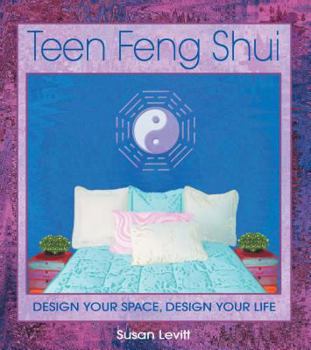Teen Feng Shui: Design Your Space, Design Your Life
Select Format
Select Condition 
Book Overview
A feng shui book specifically for teens. - Shows how to create balanced teen environments that promote personal development and positive self expression. - Tailors solutions to teen spaces: bedrooms, dormitories, desks, drawers, and lockers. - Shows how, when, and where to use music, incense, and posters. - Addresses real teen issues such as body image, tattoos and piercings, and cigarettes and other drugs. Teen Feng Shui demonstrates how the universal principles behind the design practice of feng shui can be applied to the contemporary environments of teenagers--from school lockers to dorm rooms--in order to maximize personal power, develop harmonious relationships, and define personal space. Noting that all books on feng shui are created for adults, Susan Levitt has provided a resource geared specifically toward the needs and realities of the teenage experience, addressing how young adults can design their living spaces to transform their lives. She describes how music, posters, and incense can influence space and includes before-and-after illustrations of feng shui "fixes." Teen Feng Shui also incorporates Chinese astrology, financial management and shopping tips for teens, insights on love and sex, personal stories, and case studies to provide a fun and comprehensive guide to this ancient art of placement.
Format:Paperback
Language:English
ISBN:0892819162
ISBN13:9780892819164
Release Date:January 2003
Publisher:Bindu Books
Length:232 Pages
Weight:1.16 lbs.
Dimensions:0.6" x 8.0" x 8.9"
Age Range:12 to 18 years
Grade Range:Grade 7 to Postsecondary
Related Subjects
Teen & Young AdultCustomer Reviews
4 ratings
Speaks to a teen
Published by Thriftbooks.com User , 16 years ago
This is an good book for any age, but especially for teens. It addresses how to make your space work for you, while respecting that a teen often has limitations put on them by their parent(s).
A Good Introduction to the "Black Hat" Style of Feng Shui
Published by Thriftbooks.com User , 18 years ago
Feng shui (which means "wind-water" in Chinese) is the art of placement. It concerns not only the placement of furniture, but also the arrangement of the environment as a whole (where land forms are, houses, towns, and so forth). The purpose of feng shui is to maximize the potential of the space within your environment, through lighting, color, types of objects, and a variety of other factors. The two major types of feng shui are the Black Hat style and Compass style. You're probably more familiar with the Compass style, which generally requires a feng shui consultation and someone using a traditional Chinese compass to determine factors in feng shui. However, the Black Hat style (which is what this book focuses on) is much more accessible for people who are not feng shui practitioners! Feng shui is about how "chi" moves throughout the environment. The philosophy is that chi is everywhere and that feng shui helps chi become as balanced as possible; problems result when chi becomes too positive or too negative. Chi is the energy or "life force" moving through all things and it is Yin (dark/feminine) and yang (light/masculine) are the two types of chi. Together, yin and yang form Tao. From yin and yang, eight "trigrams" are derived; these are the stacked lines, which are the same as are used in the I Ching for divination. In the Black Hat style of feng shui, they correspond to different sections of a room. Yang's trigrams are Heaven (Helpful People/Travel), Lake (Creativity/Children), Fire (Fame/Reputation), and Thunder (Family/Health). Yin's trigrams are Wind (Wealth), Water (Career), Mountain (Knowledge), and Earth (Relationships/Romance). These eight are referred to as the Ba Gua. The grid used in the book shows the locations of these sections, which could be applied to any room in your house. The book goes on to explain the steps of using feng shui for your room, beginning with removing clutter and then focusing on the specific sections of the room. Important objects (such as beds, computers, TVs, and stereos) are given special consideration for placement. Not only does each section that follow focus on the particular section of the Ba Gua and what to put in it, but also discusses the topic involved. For example, not only is the Mountain/Knowledge section described a favorable place for reading, meditation, placing bookcases, religious/divinatory materials, and objects related to hobbies, but the book goes on to explain the importance of mediation, keeping a journal, and understanding more about yourself. After the Ba Gua is covered, the relationship of the five elements (Fire, Earth, Metal, Water, and Wood) is discussed. Each element corresponds to a different color, shape, and material in feng shui. In Chinese astrology, your birth year determines your zodiac animal as well as your element (lists of years for both are given in this book). The only problem that I have with this section is that it incorrectly lists the yin/yang polarity
wow
Published by Thriftbooks.com User , 21 years ago
Great book! Unlike a ton of feng shui books, this one you can actually read and understand. Very good, for teens and adults. Very thorough explanations.
A Breath of Fresh Air!
Published by Thriftbooks.com User , 21 years ago
I've read dozens of books on feng shui, but this was the clearest, easiest to follow, and most heartfelt of them all. You don't have to be a teen to appreciate the wisdom and guidance contained within these pages. The depth of the author's knowledge of her subject is evident throughout. I was especially intrigued by the chapter that integrates Chinese astrology with feng shui applications. Everyone should read this new approach, regardless of age. Highly recommended!






